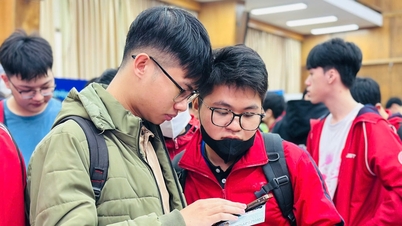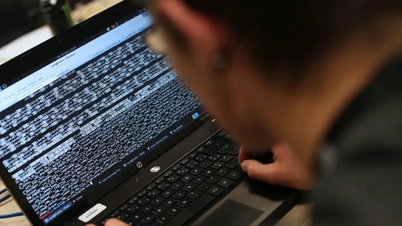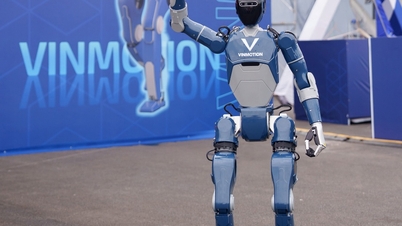In a building in Manila's financial district (Philippines), about 60 young employees are operating robots that arrange goods in convenience stores in Tokyo (Japan). When the robots encounter problems, such as dropping a can of soda, they wear virtual reality glasses and use joysticks to handle the situation.
These robots were developed by the Tokyo-based startup Telexistence, using Nvidia and Microsoft platforms. Since 2022, they have been deployed in over 300 FamilyMart and Lawson stores, and will soon be available at 7-Eleven.
Juan Paolo Villonco, founder of Astro Robotics – a company that operates robots in Manila – said: “It’s very difficult to find warehouse workers in Japan. And if you do, the cost is very high.”
Each operator will monitor approximately 50 robots. The majority of robots operate autonomously, but about 4% of cases require manual intervention. For example, when a robot drops a bottle and it rolls away. Making the robot able to pick it up by perfectly mimicking human grip – friction, the feel of metal in the hand – is one of the biggest challenges in robotics. Only then does the operator need to intervene.

When the robot drops a can of soda, workers at Astro Robotics use a virtual reality device to help retrieve it. (Source: Rest of World)
Technology workers: Opportunities and trade-offs
The Philippines, a global outsourcing hub, has seen steady recruitment demand for automation and AI-related positions from international companies, according to Jose Mari Lanuza, lead researcher at the Sigla Technology Research Center in Manila.
"IT companies are racing to find cheap labor," he said.
These positions require higher technical skills than content moderation or large-scale language modeling training—types of work typically associated with developing countries.
But even these positions face familiar trade-offs: They are often only hired on temporary contracts and receive lower salaries than their counterparts in developed countries. Some such positions can even cause people to lose more of their self-worth than being replaced by machines or AI, according to Lionel Robert, a professor of robotics at the University of Michigan.
"Now, they no longer lose their jobs because of machines, but instead become supervisors of the machines. You're like a 'replacement' version of a robot," he said.
Rowel Atienza, a professor of machine learning at the University of the Philippines, shared that one-third of his students are hired by foreign companies, including those based in the United States.
Those who operate these remote robots face immense pressure. They report often feeling dizzy and lightheaded due to VR-related motion sickness, a type of seasickness associated with VR. This condition is linked to the amount of time they use the VR headset. In a typical 8-hour shift, they operate the robot around 50 times, with each operation taking up to 5 minutes to fix a problem.

A worker remotely arranges goods for a convenience store in Japan. (Source: NextShark)
Automation does not mean job losses.
Automation is accelerating globally. According to MarkNtel Advisors, the AI market is expected to grow eightfold, reaching $43 billion by 2030, while the industrial robotics market will also nearly double.
Professor Lionel Robert from the University of Michigan stated: "The combination of automation and the relocation of manufacturing overseas is a turning point for many countries, including the United States."
He argued that automation could reduce the number of local jobs, but would increase the demand for skilled labor – who would be paid more. However, the cost of developing AI systems in the US is very high: from $10,000 for a basic chatbot to $300,000 for an enterprise-level system. Meanwhile, this cost is much lower in the Philippines.

"The future will see a 'hybrid' workforce of robots, AI, automation, and humans," Professor Lionel Robert stated. (Image: Rest of World)
In the Philippines, a future of "hybrid" humans and machines is already emerging. Besides IT service jobs, young engineers there are contributing to building AI systems for global corporations such as Amazon and Coca-Cola.
Despite the rapid development of AI, Professor Lionel Robert asserts: "Complete automation will not happen. Humans will still be very useful. The future will have a 'hybrid' workforce of robots, AI, automation, and humans."
According to a survey by the World Economic Forum of 1,000 employers worldwide, the proportion of jobs that are solely human-only is projected to decline rapidly in the near future. Notably, 41% of them indicated they are likely to cut staff because workers' skills are no longer suitable for the new demands of the automation and artificial intelligence era.
Source: https://vtcnews.vn/ngoi-o-philippines-ky-su-dieu-khien-robot-o-nhat-ban-lao-dong-so-thoi-ai-ar973090.html




![[Photo] Prime Minister Pham Minh Chinh receives the Governor of Tochigi Province (Japan)](/_next/image?url=https%3A%2F%2Fvphoto.vietnam.vn%2Fthumb%2F1200x675%2Fvietnam%2Fresource%2FIMAGE%2F2025%2F12%2F16%2F1765892133176_dsc-8082-6425-jpg.webp&w=3840&q=75)
![[Photo] Prime Minister Pham Minh Chinh receives Lao Minister of Education and Sports Thongsalith Mangnormek](/_next/image?url=https%3A%2F%2Fvphoto.vietnam.vn%2Fthumb%2F1200x675%2Fvietnam%2Fresource%2FIMAGE%2F2025%2F12%2F16%2F1765876834721_dsc-7519-jpg.webp&w=3840&q=75)
![[Live] 2025 Community Action Awards Gala](/_next/image?url=https%3A%2F%2Fvphoto.vietnam.vn%2Fthumb%2F1200x675%2Fvietnam%2Fresource%2FIMAGE%2F2025%2F12%2F16%2F1765899631650_ndo_tr_z7334013144784-9f9fe10a6d63584c85aff40f2957c250-jpg.webp&w=3840&q=75)
![[Image] Leaked images ahead of the 2025 Community Action Awards gala.](/_next/image?url=https%3A%2F%2Fvphoto.vietnam.vn%2Fthumb%2F1200x675%2Fvietnam%2Fresource%2FIMAGE%2F2025%2F12%2F16%2F1765882828720_ndo_br_thiet-ke-chua-co-ten-45-png.webp&w=3840&q=75)

































































![[Photo] Prime Minister Pham Minh Chinh attends the Vietnam Economic Forum 2025](https://vphoto.vietnam.vn/thumb/402x226/vietnam/resource/IMAGE/2025/12/16/1765893035503_ndo_br_dsc-8043-jpg.webp)





































Comment (0)